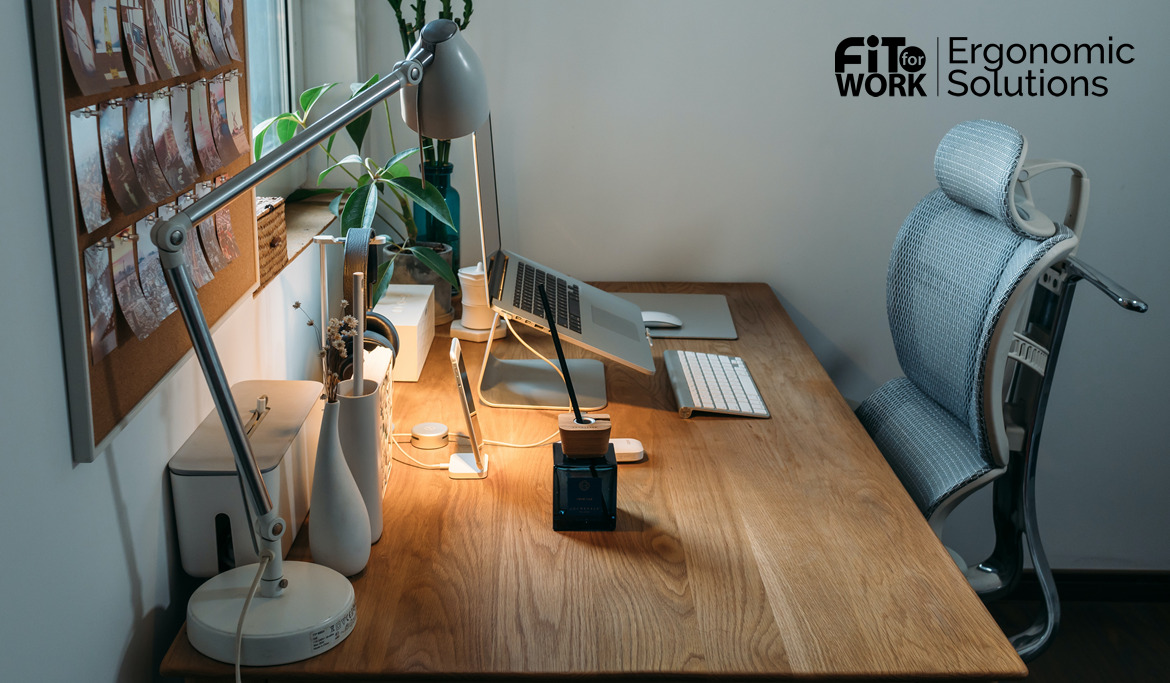Table of contents:
2. What is computer workstation ergonomics & why is it important?
3. Checklists on how to set up an ergonomic computer workstation
4. Environmental conditions relating to ergonomics of computer workstations
5. Ergonomic tips for computer users
Do you have employees who often complain of back pain, shoulder pain, neck pain, or headache? Have you checked whether your computer workstations are correctly set up? Considering the ergonomics of your computer workstations can help you discover the causes of the pain and discomfort and how to solve the problems.

According to the Department of Health under the Victorian Government, computer-related injuries include back, neck, and shoulder/arm discomfort, and one of the things that exacerbate muscle and joint issues is poor workstation design.
Your employees sit in front of a computer for hours every day without knowing what it does to their bodies. Little do they know, they injure their bodies by extending their arms, slouching, and squinting to look at computers that aren’t in the right place.
These practices can result in cumulative trauma illnesses or injuries, impacting their health. But don’t fret! It’s still possible to provide an ergonomic computer workstation. It will provide benefits not only for them but also for you and your company.
As you continue reading, you will learn proper computer workstation ergonomics, its importance, how to set up workstation components, the environmental conditions that affect the workstation, and some tips for computer users.
What is computer workstation ergonomics & why is it important?
If you are not yet familiar with or have forgotten about the definition of ergonomics, you can read this to understand computer workstation ergonomics better.
Meanwhile, an ergonomically correct computer workstation means the setup of your computer desk protects you from computer vision syndrome, neck and back pain, or carpal tunnel syndrome. It also prevents you from getting other problems with your muscles, back, and joints.
You might think it’s enough for your employees to have spacious desks, monitors in front of them, and mouses and keyboards to feel “comfortable.” However, unless their workplaces undergo an ergonomic assessment, you can’t be sure they have good DSE workstation ergonomics.
Several studies have discovered that improper workstations cause musculoskeletal diseases (MSDs) and eyestrain. MSD symptoms include back pain, neck pain, hand, arm, and leg tingling, and more. Eyestrain symptoms are headache, eye dryness, blurred vision, changes in perception of colours, and eye fatigue.
These unwanted injuries and discomfort may be inevitable, but this is where computer workstation ergonomics intervenes. Implementing an ergonomically designed computer workstation is important because it helps prevent risks and protects your employees’ health. Eventually, your employees will enjoy working, be more productive, and lessen their absences.
We know you need a guide on the proper ergonomic setup of a computer workstation, so keep reading to discover what you’ll need to do.
Checklists on how to set up an ergonomic computer workstation
A computer workstation setup has several components, so you also need to consider each item to achieve an ergonomic computer workstation.
As you read the following computer workstation checklists, remember that each employee is unique. You must not assume that each item suits everyone in your workplace.
Here are the guidelines to achieve workstation ergonomics using them.
Desks
- The desk surface allows you to place the monitor directly in front of you, at least 20 inches away.
- The desk accommodates a variety of working postures.
- There is no clutter below the desk (e.g., CPU, boxes, etc.) because it could consume the space for your legs and chair positioning.
- The desk height provides adequate clearance for your legs and your chair.
Monitors
- The monitor is directly in front of you and at least 20 inches away, and you can still use the backrest of your chair.
- The top line of the screen on your monitor is either at or below eye level.
- If you use two monitors equally, they are placed together directly in front of you.
- If you are using two monitors and one of them is used occasionally, the primary monitor should be right in front of you, and the secondary monitor should be right next to it.
- Whether you are using two monitors equally or otherwise, both are adjusted to the same height.
Keyboards

- The keyboard is placed directly in front of you.
- You use a platform that raises the keyboard, which is stable and big enough to hold it.
- Your wrists and hands do not come into contact with any edges that are sharp or rough.
- The keyboard can be adjusted so that your hands are over the keyboard and your elbows are close to your torso at an angle of 90° to 100°.
Mouse
- The mouse is close to the keyboard.
- The mouse is as close to the body’s midline and at the same level as the keyboard.
- The mouse is simple to use, and its shape/size is appropriate for the hand (not too big/small).
- There is an extra mouse that can be used with either hand to allow rest for the hand you often use.
Chairs

- You can raise or lower the chair to position your arms at a 90-degree angle.
- The chair is wide enough to provide comfortable, uniform pressure across the entire seat and permit posture adjustments. The width is between 17 and 20 inches.
- The armrests give support and distribute it equally across the arms.
- The chair has a lumbar support that allows your lower back to arch slightly.
- The chair’s backrest is strong, and there are no pressure points that prevent your blood from flowing.
- It has an adjustable and lockable backrest.
To learn more, read our article about an ergonomic chair.
Laptops
- If you use a laptop as your primary computer, it is set up with the same ergonomic principles as desktop computers.
- You use a separate keyboard and mouse.
- It should be raised to eye level.
Supplemental lighting
- The brightness level and light colour are appropriate for your tasks.
- The lamp doesn’t flicker.
- There is no direct glare on your computer screen coming from your lamp.
- The brightness level is adjustable.
- Task lighting on the documents you work on does not cause glare on the monitor.
Document holders
- The document holder allows you to keep documents at or about the same distance and height as the monitor.
- It is stable when loaded with heavier documents (e.g., books).
- If you use a document holder while you work, it is positioned directly beneath the monitor.
Telephones

- You use a headset or speakerphone for long conversations.
- It is close enough to prevent you from reaching repeatedly.
- The telephone cord is kept out of working areas as it might create a tripping hazard.
- If you use a speakerphone, it’s at an appropriate volume to avoid disrupting your co-workers.
Palm & wrist supports
- You use a wrist rest to keep your wrist straight and lessen contact stress during typing and mousing tasks.
- Your hands can move freely and are elevated above the wrist/palm rest while you are typing.
- When your hands rest, the pad contacts the palm of your hand, not your wrists.
- The wrist/palm support is relatively soft and rounded to lessen pressure on the wrist.
- It is at least 1.5 inches deep.
- It is not used with a vertical mouse.
These computer workstation ergonomics self-assessment checklists are meant to be used by you and your employees. However, these are only some general points. You can check our other blogs to learn more about each component.
Environmental conditions relating to ergonomics of computer workstations
Putting lights in the right places and choosing the proper brightness can help you see monitor images better. For instance, if the lighting is too bright or makes the monitor screen glare, you may get headaches or eye strain and have to work in unnatural positions to see the screen.
At the same time, ventilation and humidity levels in your workplace may affect how comfortable and productive people feel there.
Because of these situations, you must consider an ergonomic workstation environment, which means the provision of the right temperature, ventilation, and lighting in the workplace in order to provide comfort and reduce hazards.
The following are the ergonomic checklists for a workstation’s environmental aspects.
Lighting

- There are rows of lights parallel to your sight line.
- There are light diffusers so that desk jobs (e.g., reading and writing) are properly done while the computer screen isn’t too bright.
- You have supplemental task or desk lighting to illuminate reading and writing tasks.
- Your office uses light, matte colours and finishes on the walls and ceilings to help reflect indirect light and reduce dark shadows and contrast.
Glare
- Your office arrangement minimises glare from windows, lamps, and overhead lights.
- You clean the monitor screen frequently.
- You use a glare filter attached directly to the monitor surface.
- You tilt down your monitor slightly to keep it from reflecting the overhead light.
Ventilation
- Your workplace maintains the right air circulation.
- You do not place your desk, chair, and other office furniture directly under air conditioning vents.
- Your office keeps relative air humidity between 30% and 60%.
- The temperature indoors ranges between 20° and 23.5° C during the warmer months and between 23° and 26° C during the cooling months.
These are just general checklists about the environment for good ergonomic practices in using computers.
Ergonomic tips for computer users
Ergonomic principles include encouragement for workers to take care of themselves while working. We all know that regardless of the lightness of one’s job, their postures, physical efforts, the items they use, and the environment play big roles in their health condition.
Here are the following ergonomic computer tips for your employees who work with computers all day.
Positioning and posture
- When working on the keyboard, keep a healthy posture and use a chair with a backrest.
- Avoid resting your elbows on the table’s hard surface or edge. If necessary, elbow pads can be utilised to protect your elbows.
- Keep wrists in neutral positions when typing or using a mouse.
Eye care

- Wear blue light glasses.
- Adjust the monitor so that your eyes remain in their natural position.
- Use glare screens to protect your eyes from different focuses.
- Rest your eyes every 20 minutes by looking 20 feet away for 20 seconds.
Workstation stretches
- For hand stretch, slide the tips of your fingers up your palm until they are near the base of your fingers. You should feel stretched. If something hurts, don’t force your fingers with your other hand.
- For shoulder stretch, raise your shoulders to your ears until you feel slight neck and shoulder tightness. Hold for 3–5 seconds. Then drop your shoulders. Repeat 2–3 times.
- For back and side stretch, interlace your fingers and lift your arms over your head, elbows straight. Press arms back. Leaning left and right slowly stretches your sides. To extend the shoulder blades and chest, bring your arms in front or behind your body.
- For hip stretch, sit cross-legged. Your arm or elbow is placed outside the crossed leg. While looking away, gently apply pressure. Switch legs.
They can always add more stretches, depending on their bodies’ needs. But of course, the stretches need to be based on the standards that prevent them from injuring themselves.
Ergonomic computer workstations: key to boosting productivity, reducing body pains, and improving overall health
As you have learned about some requirements for computer workstation ergonomics, it’s time to implement them and share the tips and checklists with your employees.
Ergonomics for the computer workstation may have given too many things to follow, but there are many studies that prove how important they are for your employees’ safety.
Moreover, you will love seeing them healthier, happier, and more motivated to work and to be productive once they consistently follow the DSE ergonomics tips.
Wait no further, and contact us for any questions about workplace ergonomics!



